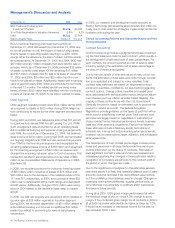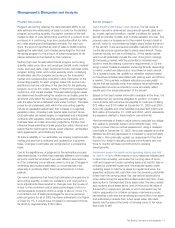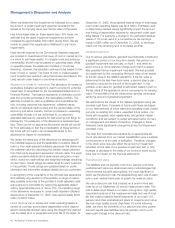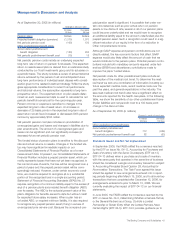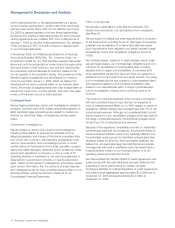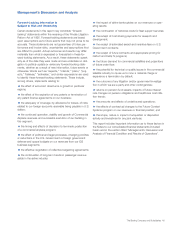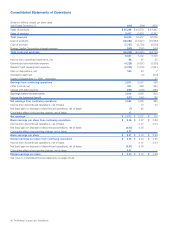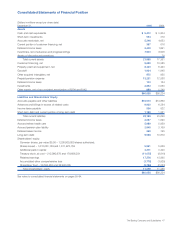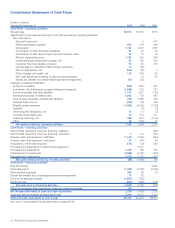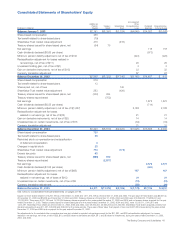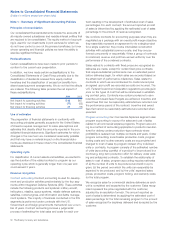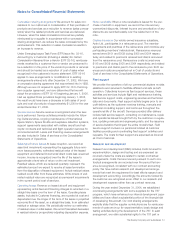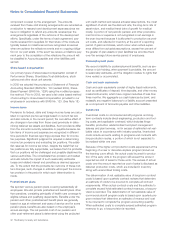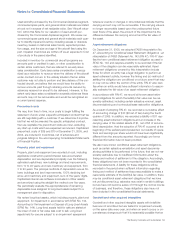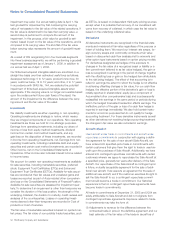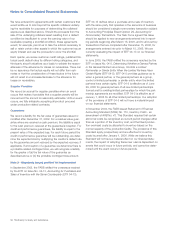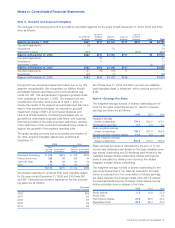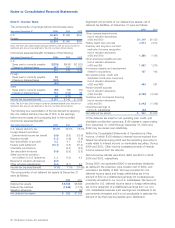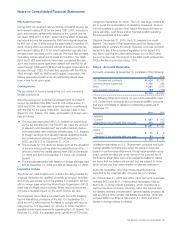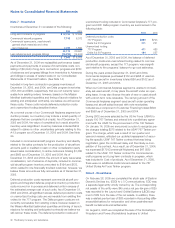Boeing 2005 Annual Report Download - page 52
Download and view the complete annual report
Please find page 52 of the 2005 Boeing annual report below. You can navigate through the pages in the report by either clicking on the pages listed below, or by using the keyword search tool below to find specific information within the annual report.
Notes to Consolidated Financial Statements
(Dollars in millions except per share data)
Note 1 - Summary of Significant Accounting Policies
Principles of consolidation
Our consolidated financial statements include the accounts of
all majority-owned subsidiaries and variable interest entities that
are required to be consolidated. The equity method of account-
ing is used for our investments in joint ventures for which we
do not have control or are not the primary beneficiary, but over
whose operating and financial policies we have the ability to
exercise significant influence.
Reclassifications
Certain reclassifications have been made to prior periods to
conform to the current year presentation.
In addition, we have made certain reclassifications to the
Consolidated Statements of Cash Flows primarily due to the
classification of dividends received from equity method
investees and the classification of excess tax benefits from
share-based payment arrangements. We do not feel the effects
are material. The following table provides the net impact of
these reclassifications.
2004 2003
Net impact to operating activities $«46 $67
Net impact to investing activities (77) (52)
Net impact to financing activities 31 (15)
Use of estimates
The preparation of financial statements in conformity with
accounting principles generally accepted in the United States
of America requires management to make assumptions and
estimates that directly affect the amounts reported in the con-
solidated financial statements. Significant estimates for which
changes in the near term are considered reasonably possible
and that may have a material impact on the financial state-
ments are disclosed in these notes to the consolidated financial
statements.
Operating cycle
For classification of current assets and liabilities, we elected to
use the duration of the related contract or program as our
operating cycle which is generally longer than one year and
could exceed 3 years.
Revenue recognition
Contract accounting Contract accounting is used for develop-
ment and production activities predominately by the four seg-
ments within Integrated Defense Systems (IDS). These activities
include the following products and systems: military aircraft,
helicopters, missiles, space systems, missile defense systems,
satellites, rocket engines, and information and battle manage-
ment systems. The majority of business conducted in the IDS
segments is performed under contracts with the U.S.
Government and foreign governments that extend over a num-
ber of years. Contract accounting involves a judgmental
process of estimating the total sales and costs for each con-
tract resulting in the development of estimated cost of sales
percentages. For each contract, the amount reported as cost
of sales is determined by applying the estimated cost of sales
percentage to the amount of revenue recognized.
We combine contracts for accounting purposes when they are
negotiated as a package with an overall profit margin objective;
they essentially represent an agreement to do a single project
for a single customer; they involve interrelated construction
activities with substantial common costs; and they are per-
formed concurrently or sequentially. When a group of contracts
is combined, revenue and profit are earned uniformly over the
performance of the combined contracts.
Sales related to contracts with fixed prices are recognized as
deliveries are made, except for certain fixed-price contracts
that require substantial performance over an extended period
before deliveries begin, for which sales are recorded based on
the attainment of performance milestones. Sales related to
contracts in which we are reimbursed for costs incurred plus
an agreed upon profit are recorded as costs are incurred. The
U.S. Federal Government Acquisition regulations provide guid-
ance on the types of cost that will be reimbursed in establish-
ing contract price. Contracts may contain provisions to earn
incentive and award fees if targets are achieved. Incentive and
award fees that can be reasonably estimated are recorded over
the performance period of the contract. Incentive and award
fees that cannot be reasonably estimated are recorded when
awarded.
Program accounting Our Commercial Airplanes segment uses
program accounting to account for sales and cost of sales
related to all commercial airplane programs. Program account-
ing is a method of accounting applicable to products manufac-
tured for delivery under production-type contracts where
profitability is realized over multiple contracts and years. Under
program accounting, inventoriable production costs, program
tooling costs and routine warranty costs are accumulated and
charged to cost of sales by program instead of by individual
units or contracts. A program consists of the estimated number
of units (accounting quantity) of a product to be produced in a
continuing, long-term production effort for delivery under exist-
ing and anticipated contracts. To establish the relationship of
sales to cost of sales, program accounting requires estimates
of (a) the number of units to be produced and sold in a pro-
gram, (b) the period over which the units can reasonably be
expected to be produced, and (c) the units’ expected sales
prices, production costs, program tooling, and warranty costs
for the total program.
We recognize sales for commercial airplane deliveries as each
unit is completed and accepted by the customer. Sales recog-
nized represent the price negotiated with the customer,
adjusted by an escalation formula. The amount reported as
cost of sales is determined by applying the estimated cost of
sales percentage for the total remaining program to the amount
of sales recognized for airplanes delivered and accepted by the
customer.
50 The Boeing Company and Subsidiaries


